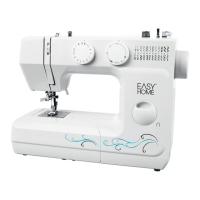37
Sewing
Darning
Mounting the darning plate
For some sewing work, e.g. sewing on buttons, hooks and eyes,
darning and embroidery, the material must not be fed through
automatically. Instead you must be able to control the feeding of the
material yourself.
In these cases, you must attach the darning plate included in the
accessories.
− Raise the presser foot lever and turn the hand wheel to raise
the needle to its highest position.
− Now push both pins of the darning plate into the openings on
the needle plate
24
until they click into place, as shown in the
diagram opposite.
− Simply lift the darning plate at the corners to remove it again.
Darning
− Remove the presser foot holder and select the normal lower
thread tension.
The upper thread tension should be somewhat lower than usual.
Presser foot: ...............................................................................................No presser foot
Program: ............................................................................................................................... A
Stitch length: ................................................................................................................1 to 4
If necessary, you can place a piece of fabric under the damaged
area.
− Place the material under the needle and lower the presser foot
lever to apply the thread tension.
− Begin sewing by slowly moving the fabric forwards and
backwards by hand.
− Repeat until the damaged area has been completely fi lled with
parallel stitches.
− If necessary, you can darn over these stitches with stitches at
right angles to them, as you do when darning by hand.
TIP
The fabric must be taut during the darning process. If the damaged
area is large, it is advisable to use an embroidery frame (available
from specialist retailers) to keep the material taut.

